The Effectiveness of Embodied Pedagogical Agents and Their Impact on Students Learning in Virtual Worlds
Abstract
1. Introduction
2. Related Work
3. The AVARES Virtual Reality Educational Environment
3.1. Educational Infrastructure
3.2. Learning Approaches and Training Activities
3.3. Embodied Pedagogical Agents
4. Experimental Evaluations
4.1. Participants
4.2. Methods and Results
5. Discussion
6. Conclusions
Author Contributions
Funding
Conflicts of Interest
References
- Allison, C.; Campbell, A.; Davies, C.J.; Dow, L.; Kennedy, S.; McCaffery, J.P.; Perera, G.I.U.S. Growing the use of Virtual Worlds in education: An OpenSim perspective. In Proceedings of the 2nd European Immersive Education Summit, Paris, France, 26–27 November 2012; pp. 1–13. [Google Scholar]
- Dalgarno, B.; Lee, M.J. What are the learning affordances of 3-D virtual environments? Br. J. Educ. Technol. 2010, 41, 10–32. [Google Scholar] [CrossRef]
- Mikropoulos, T.A.; Natsis, A. Educational virtual environments: A ten-year review of empirical research (1999–2009). Comput. Educ. 2011, 56, 769–780. [Google Scholar] [CrossRef]
- Grivokostopoulou, F.; Perikos, I.; Hatzilygeroudis, I. An innovative educational environment based on virtual reality and gamification for learning search algorithms. In Proceedings of the 2016 IEEE Eighth International Conference on Technology for Education (T4E 2016), Mumbai, India, 2–4 December 2016; pp. 110–115. [Google Scholar]
- Chesney, T.; Chuah, S.H.; Hoffmann, R. Virtual world experimentation: An exploratory study. J. Econ. Behav. Organ. 2009, 72, 618–635. [Google Scholar] [CrossRef][Green Version]
- De Freitas, S.; Rebolledo-Mendez, G.; Liarokapis, F.; Magoulas, G.; Poulovassilis, A. Learning as immersive experiences: Using the four-dimensional framework for designing and evaluating immersive learning experiences in a virtual world. Br. J. Educ. Technol. 2010, 41, 69–85. [Google Scholar] [CrossRef]
- Liew, T.W.; Su-Ma, T.; Jayothisa, C. The effects of peer-like and expert-like pedagogical agents on learners’ agent perceptions, task-related attitudes, and learning achievement. J. Educ. Technol. Soc. 2013, 16, 275–286. [Google Scholar]
- Searls, D.B. Ten simple rules for online learning. PLoS Comput. Biol. 2012, 8, e1002631. [Google Scholar] [CrossRef] [PubMed]
- Veletsianos, G.; Russell, G.S. Pedagogical agents. In Handbook of Research on Educational Communications and Technology; Springer: New York, NY, USA, 2014; pp. 759–769. [Google Scholar]
- Banakou, D.; Chorianopoulos, K. The effects of avatars’ gender and appearance on social behavior in online 3D virtual worlds. J. Virtual Worlds Res. 2010, 2. [Google Scholar] [CrossRef]
- Mayer, R.E.; Dow, G.T.; Mayer, S. Multimedia learning in an interactive self-explaining environment: What works in the design of agent-based microworlds? J. Educ. Psychol. 2003, 95, 806–813. [Google Scholar] [CrossRef]
- Soliman, M.; Guetl, C. Intelligent pedagogical agents in immersive virtual learning environments: A review. In Proceedings of the 2010 33rd International Convention, Opatija, Croatia, 24–28 May 2010; pp. 827–832. [Google Scholar]
- Soliman, M.; Guetl, C. Implementing Intelligent Pedagogical Agents in virtual worlds: Tutoring natural science experiments in OpenWonderland. In Proceedings of the 2013 IEEE Global Engineering Education Conference (EDUCON 2013), Berlin, Germany, 13–15 March 2013; pp. 782–789. [Google Scholar]
- Lester, J.C.; Converse, S.A.; Kahler, S.E.; Barlow, S.T.; Stone, B.A.; Bhogal, R.S. The persona effect: Affective impact of animated pedagogical agents. In Proceedings of the ACM SIGCHI Conference on Human factors in computing systems, Altanta, GA, USA, 22–27 March 1997; pp. 359–366. [Google Scholar]
- Louwerse, M.M.; Graesser, A.C.; Lu, S.; Mitchell, H.H. Social cues in animated conversational agents. Appl. Cogn. Psychol. 2005, 19, 693–704. [Google Scholar] [CrossRef]
- Mayer, R.E.; Sabko, K.; Mautone, P. Social cues in multimedia learning: Role of speaker’s voice. J. Educ. Psychol. 2003, 95, 419–425. [Google Scholar] [CrossRef]
- Schroeder, N.L.; Adesope, O.O.; Gilbert, R.B. How effective are pedagogical agents for learning? A meta-analytic review. J. Educ. Comput. Res. 2013, 49, 1–39. [Google Scholar] [CrossRef]
- Li, J.; Kizilcec, R.; Bailenson, J.; Ju, W. Social robots and virtual agents as lecturers for video instruction. Comput. Hum. Behav. 2016, 55, 1222–1230. [Google Scholar] [CrossRef]
- Clark, R.C.; Mayer, R.E. E-Learning and the Science of Instruction: Proven Guidelines for Consumers and Designers of Multimedia Learning; John Wiley & Sons: Hoboken, NJ, USA, 2011. [Google Scholar]
- Christopoulos, A.; Conrad, M.; Shukla, M. Learner Experience in Hybrid Virtual Worlds: Interacting with Pedagogical Agents. In Proceedings of the 11th International Conference on Computer Supported Education, Heraklion, Crete, Greece, 2–4 May 2019; Scite Press; pp. 488–495. [Google Scholar]
- Heidig, S.; Clarebout, G. Do pedagogical agents make a difference to student motivation and learning? Educ. Res. Rev. Elsevier 2011, 6, 27–54. [Google Scholar] [CrossRef]
- Pour, P.A.; Hussain, M.S.; AlZoubi, O.; D’Mello, S.; Calvo, R.A. The Impact of System Feedback on Learners’ Affective and Physiological States. InIntelligenttutoring Systems; Springer: Berlin/Heidelberg, Germany, 2010; pp. 264–273. [Google Scholar]
- Ning, W.; Johnson, W.L.; Mayer, R.E.; Rizzo, P.; Shaw, E.; Collins, H. The politeness effect: Pedagogical agents and learning outcomes. Int. J. Hum. Comput. Stud. 2008, 66, 98–112. [Google Scholar]
- Christopoulos, A.; Conrad, M.; Shukla, M. What Does the Pedagogical Agent Say? In Proceedings of the 2019 10th International Conference on Information, Intelligence, Systems and Applications (IISA), Patras, Greece, 15–17 July 2019; pp. 1–7. [Google Scholar]
- Moreno, R.; Mayer, R.E.; Spires, H.A.; Lester, J.C. The case for social agency in computer-based teaching: Do students learn more deeply when they interact with animated pedagogical agents? Cogn. Instr. 2001, 19, 177–213. [Google Scholar] [CrossRef]
- Hay, K.E.; Barab, S.A. Constructivism in practice: A comparison and contrast of apprenticeship and constructionist learning environments. J. Learn. Sci. 2001, 10, 281–322. [Google Scholar] [CrossRef]
- Grivokostopoulou, F.; Perikos, I.; Kovas, K.; Hatzilygeroudis, I. Teaching Renewable Energy Sources Using 3D Virtual World Technology. In Proceedings of the 2015 IEEE 15th International Conference on Advanced Learning Technologies (ICALT 2015), Hualien, Taiwan, 6–9 July 2015; pp. 472–474. [Google Scholar]
- Hamari, J.; Koivisto, J.; Sarsa, H. Does gamification work?—A literature review of empirical studies on gamification. In Proceedings of the 47th Hawaii International Conference on System Sciences (HICSS), Waikoloa, HI, USA, 6–9 January 2014; pp. 3025–3034. [Google Scholar]
- Grivokostopoulou, F.; Perikos, I.; Kovas, K.; Hatzilygeroudis, I. Learning Approaches in a 3D Virtual Environment for Learning Energy Generation from Renewable Sources. In Proceedings of the FLAIRS Conference, Key Largo, FL, USA, 16–18 May 2016; pp. 497–500. [Google Scholar]
- Grivokostopoulou, F.; Paraskevas, M.; Perikos, I.; Nikolic, S.; Kovas, K.; Hatzilygeroudis, I. Examining the Impact of Pedagogical Agents on Students Learning Experience in Virtual Worlds. In Proceedings of the 2018 IEEE International Conference on Teaching, Assessment, and Learning for Engineering (TALE), Wollongong, Australia, 4–7 December 2018; IEEE; pp. 602–607. [Google Scholar]
- Shute, V.J. Focus on formative feedback. Rev. Educ. Res. 2008, 78, 153–189. [Google Scholar] [CrossRef]
- Brooke, J. SUS-A quick and dirty usability scale. Usability Eval. Ind. 1996, 189, 4–7. [Google Scholar]
- Bangor, A.; Kortum, P.; Miller, J. An empirical evaluation of the System Usability Scale. Int. J. Hum. Comput. Interact. 2008, 24, 574–594. [Google Scholar] [CrossRef]
- Cronbach, L.J. Coefficient alpha and the internal structure of tests. Psychometrika 1951, 16, 297–334. [Google Scholar] [CrossRef]
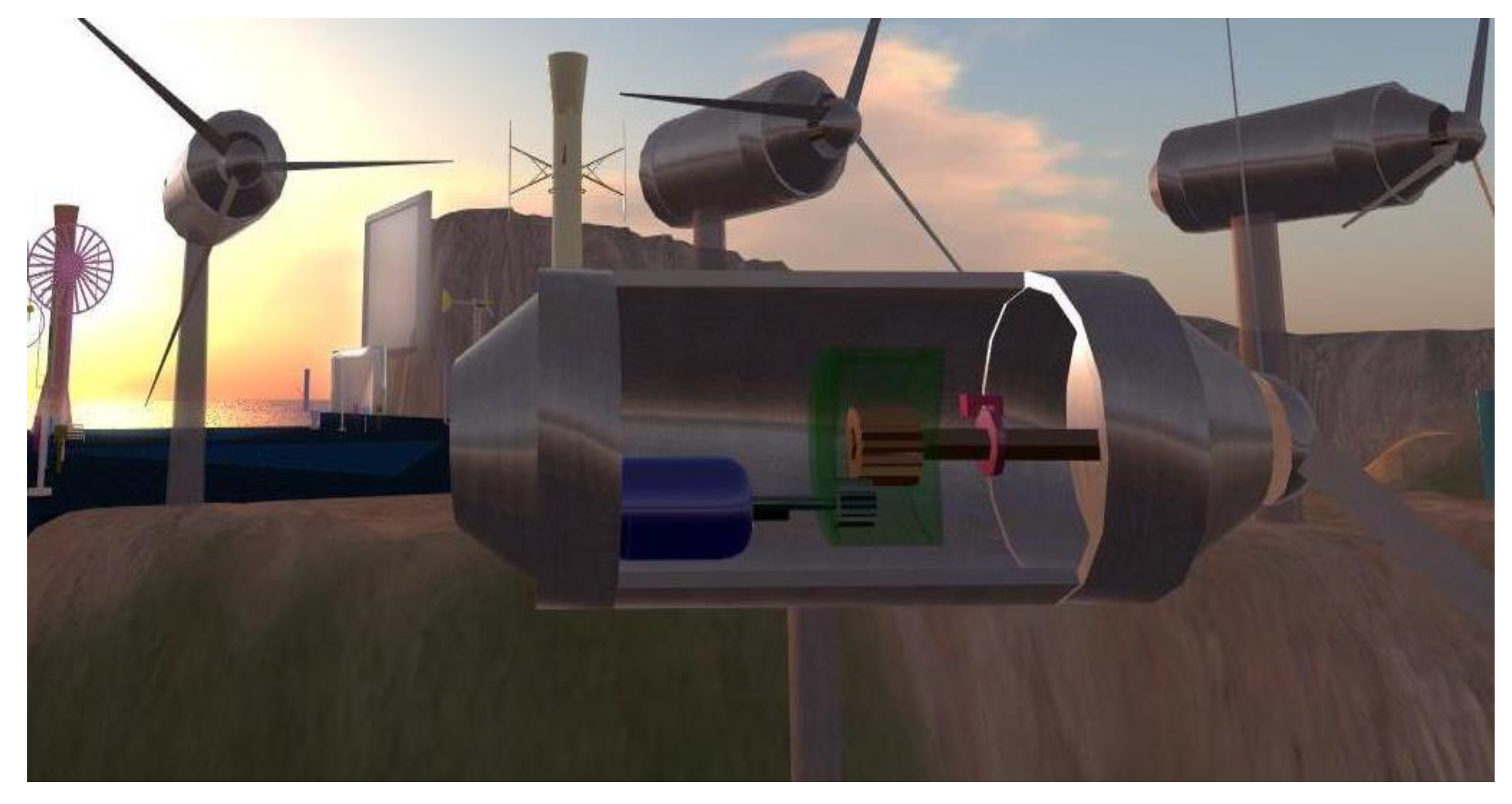
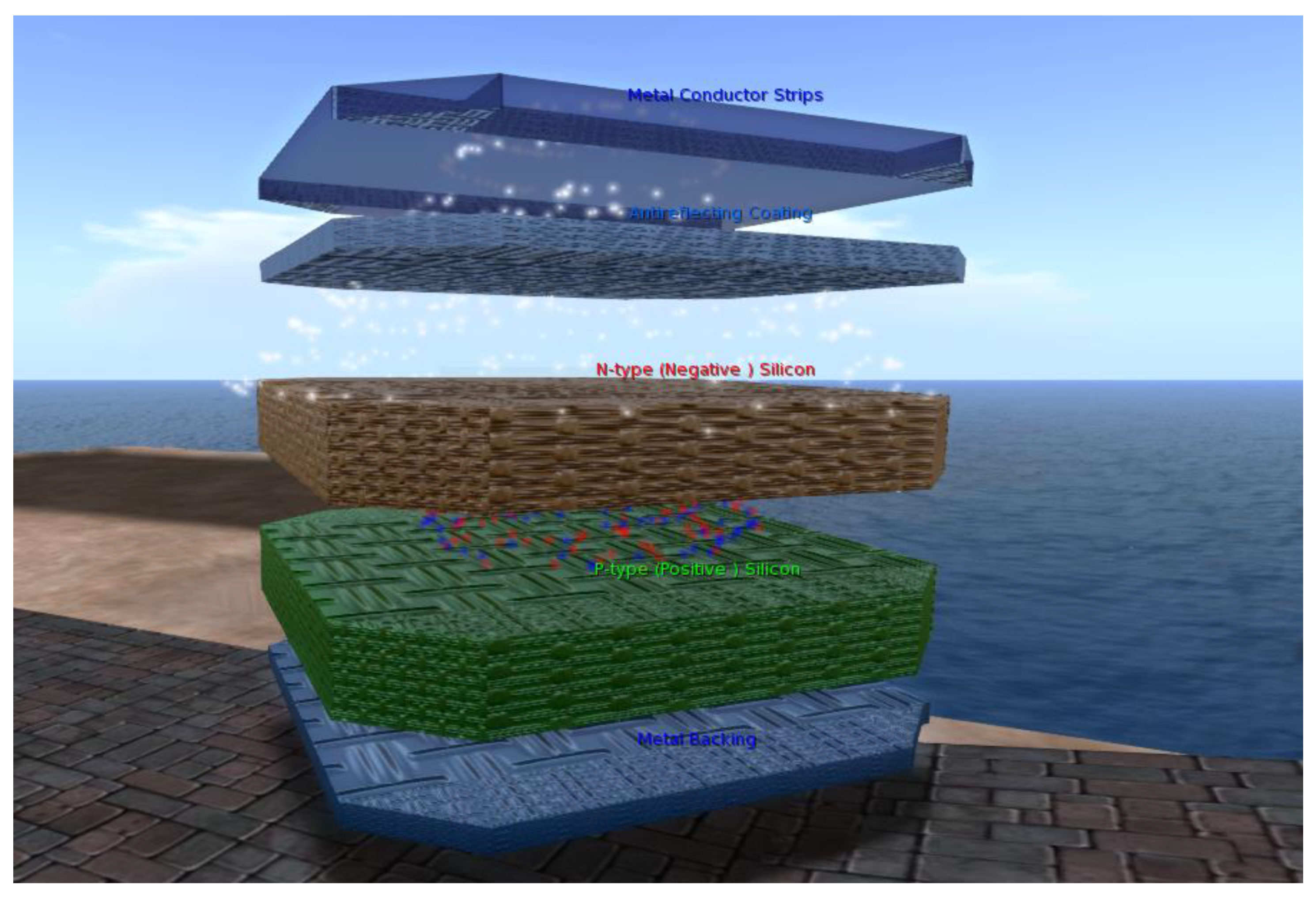
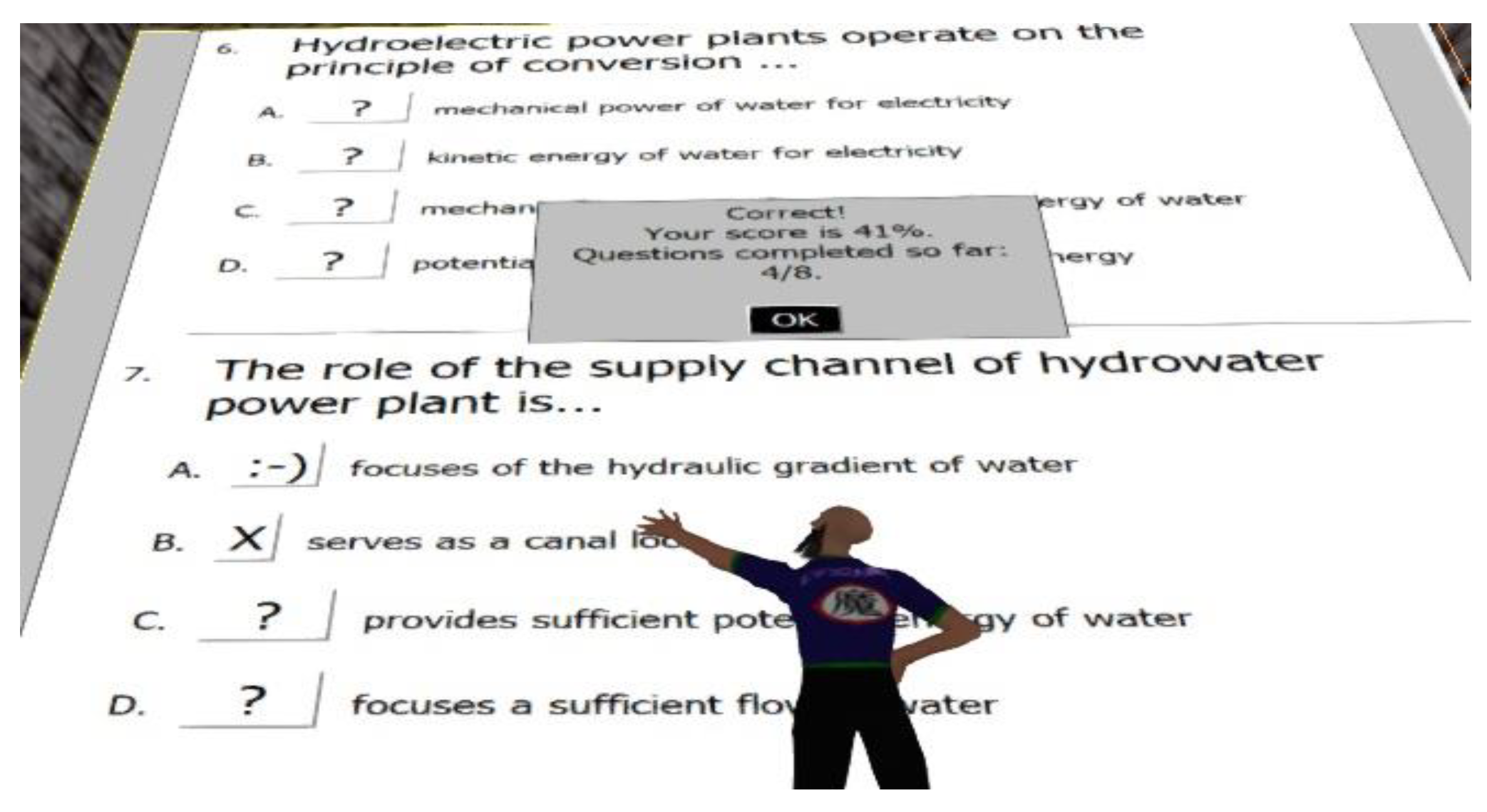
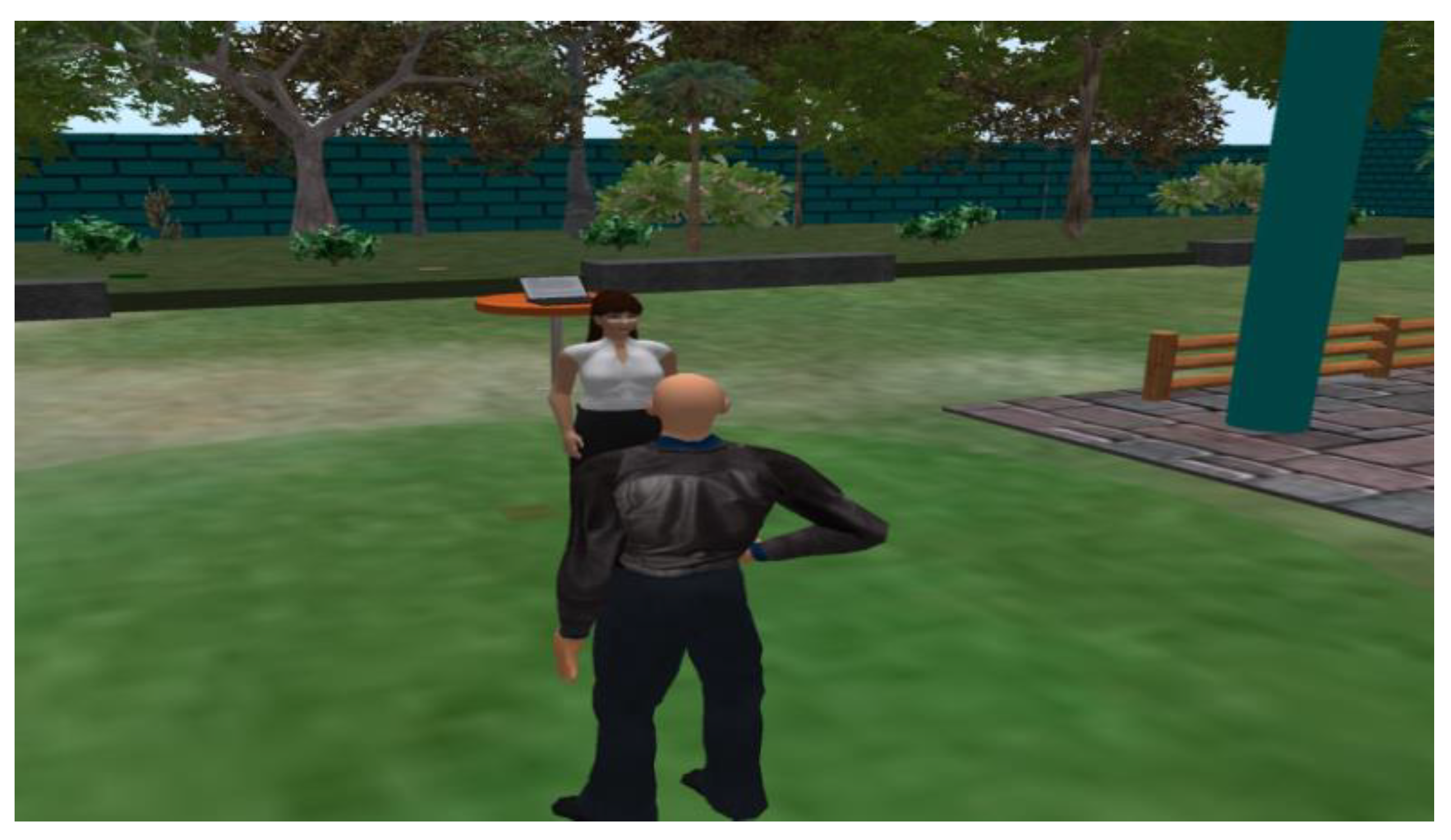
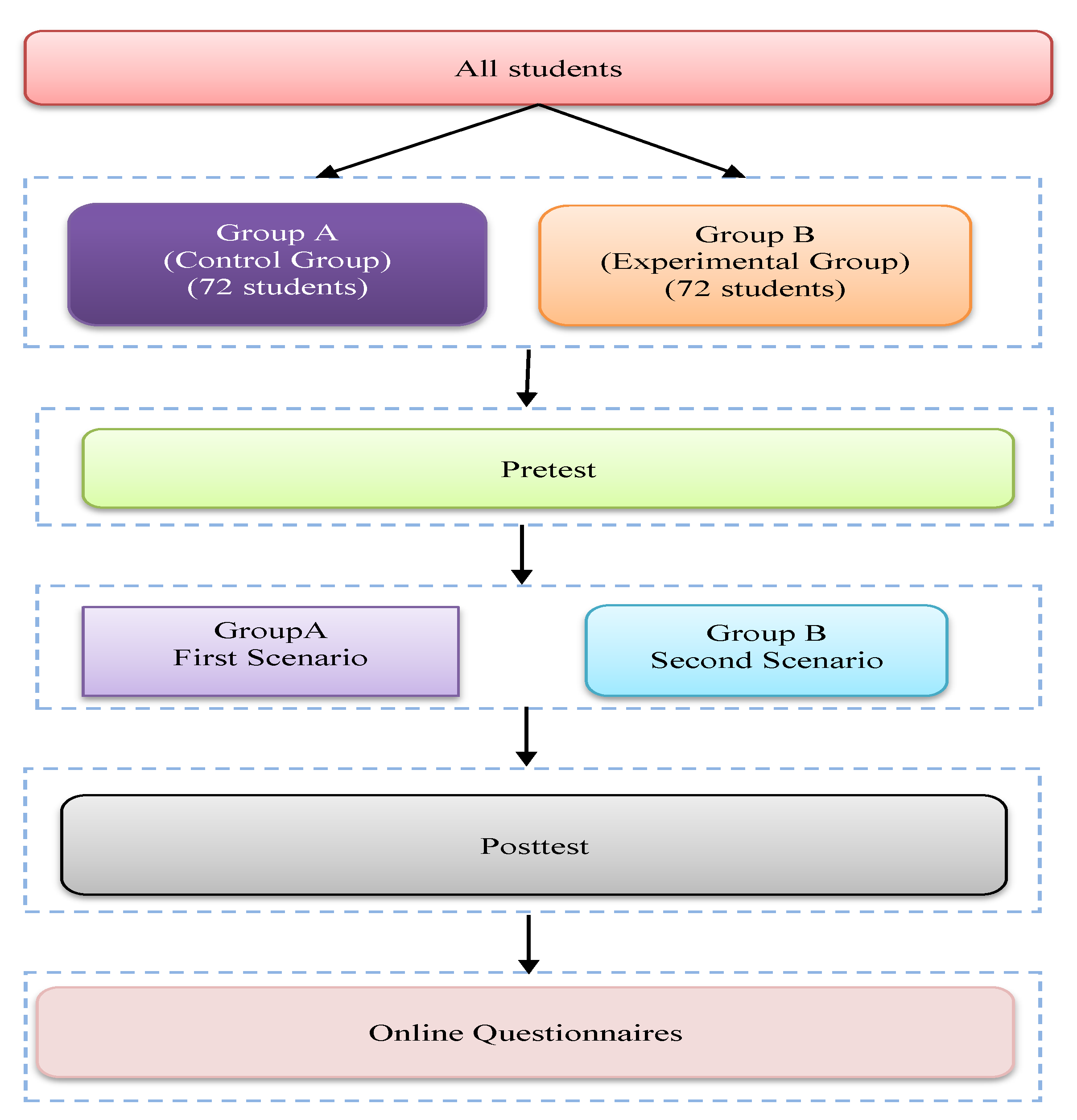
| Group | N | Mean | Standard Deviation | |
|---|---|---|---|---|
| Pre-test | GroupA | 72 | 4.201 | 0.540 |
| GroupB | 72 | 4.368 | 0.639 | |
| Post-test | GroupA | 72 | 6.750 | 0.745 |
| GroupB | 72 | 8.090 | 0.983 |
| Equality of Variance | Levene’s Test for Equality of Variances | t-Test for Mean | ||||||
|---|---|---|---|---|---|---|---|---|
| F | Sig. | t | df | Sig.(2-Tailed) | MD | 95% Confidence Interval of the Difference Lower, Upper | ||
| Pre-Test | Equal | 8.514 | 0.004 | −1.759 | 142 | 0.081 | −0.174 | −0.368, 0.021 |
| Unequal | −1.759 | 138.231 | 0.081 | −0.174 | −0.368, 0.021 | |||
| Post-Test | Equal | 14.969 | 0.000 | −9.214 | 142 | 0.000 | −1.340 | −1.627, −1.052 |
| Unequal | −9.214 | 132.377 | 0.000 | −1.340 | −1.628, −1.052 | |||
| Question | GroupA | GroupB | ||||
|---|---|---|---|---|---|---|
| Disagree/Strongly Disagree | Neutral | Agree/Strongly Agree | Disagree/Strongly Disagree | Neutral | Agree/Strongly Agree | |
| I enjoyed using the 3D virtual reality environment | 2.78% | 34.72% | 62.50% | 2.78% | 20.83% | 76.39% |
| The assistance during the learning activities was helpful and assisted me. | 5.56% | 20.83% | 73.61% | 4.17% | 15.28% | 80.56% |
| I feel comfortable and confident during the learning activities. | 4.17% | 19.44% | 76.39% | 2.78% | 12.50% | 84.72% |
| The learning activities made me more active in the activities. | 4.17% | 13.89% | 81.94% | 4.17% | 15.28% | 80.56% |
| The learning activities increase my motivation. | 4.17% | 16.67% | 79.17% | 2.78% | 13.89% | 83.33% |
| The learning activities enhance my engagement. | 5.56% | 13.89% | 80.56% | 4.17% | 11.11% | 84.72% |
| The learning activities enhance my learning interest. | 5.56% | 12.50% | 81.94% | 4.17% | 9.72% | 86.11% |
| The learning activities enhance my cooperation with my peers | 5.56% | 11.11% | 83.33% | 4.17% | 11.11% | 84.72% |
| I recommend the 3D virtual reality environment to other classmates and to be integrated into the course curriculum. | 5.56% | 12.50% | 81.94% | 4.17% | 15.28% | 80.56% |
| Please rate you overall learning experience | 6.94% | 8.33% | 84.72% | 5.56% | 12.50% | 81.94% |
| Metric | GroupA | GroupB |
|---|---|---|
| Time spent studying in the AVARES 3D virtual world environment | 33.33 (hours) | 39.25 (hours) |
| Mean value of students performance in the system’s training activities and exercises | 5.1/10 | 6.2/10 |
© 2020 by the authors. Licensee MDPI, Basel, Switzerland. This article is an open access article distributed under the terms and conditions of the Creative Commons Attribution (CC BY) license (http://creativecommons.org/licenses/by/4.0/).
Share and Cite
Grivokostopoulou, F.; Kovas, K.; Perikos, I. The Effectiveness of Embodied Pedagogical Agents and Their Impact on Students Learning in Virtual Worlds. Appl. Sci. 2020, 10, 1739. https://doi.org/10.3390/app10051739
Grivokostopoulou F, Kovas K, Perikos I. The Effectiveness of Embodied Pedagogical Agents and Their Impact on Students Learning in Virtual Worlds. Applied Sciences. 2020; 10(5):1739. https://doi.org/10.3390/app10051739
Chicago/Turabian StyleGrivokostopoulou, Foteini, Konstantinos Kovas, and Isidoros Perikos. 2020. "The Effectiveness of Embodied Pedagogical Agents and Their Impact on Students Learning in Virtual Worlds" Applied Sciences 10, no. 5: 1739. https://doi.org/10.3390/app10051739
APA StyleGrivokostopoulou, F., Kovas, K., & Perikos, I. (2020). The Effectiveness of Embodied Pedagogical Agents and Their Impact on Students Learning in Virtual Worlds. Applied Sciences, 10(5), 1739. https://doi.org/10.3390/app10051739






